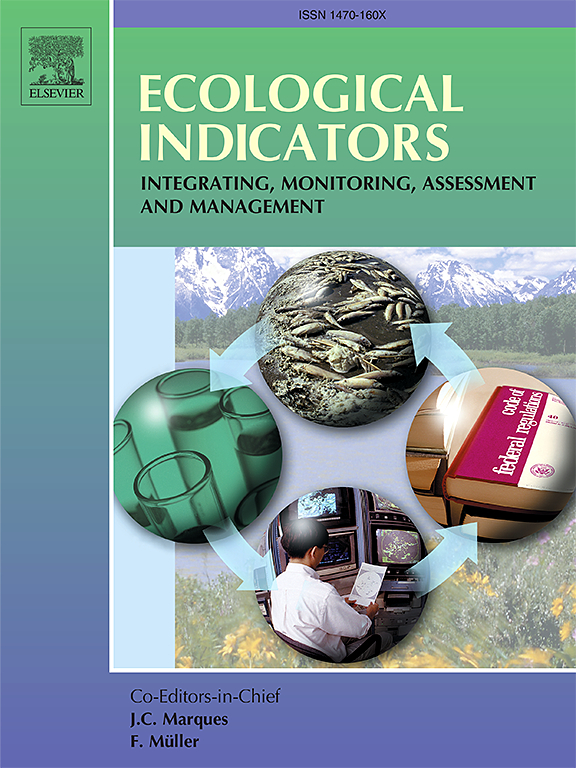Ecological benefit assessment and impact factor analysis of restoration in the Hanjiang River basin, Guangdong, based on ecosystem services
IF 7
2区 环境科学与生态学
Q1 ENVIRONMENTAL SCIENCES
引用次数: 0
Abstract
Rapid industrialization and urbanization have fueled socioeconomic growth, but have also caused ecological degradation. Therefore, ecological restoration has become essential for maintaining environmental quality. Evaluating the effectiveness of ecological restoration is critical for determining whether objectives have been met and for guiding further ecosystem management decisions. This study evaluated the ecological benefits and influencing factors of restoration in the middle and upper reaches of the Hanjiang River network in Guangdong Province, China, from 2000 to 2023. Redundancy analysis identified the key factors affecting ecological benefits and their relative contributions. The results indicated that the value of ecosystem services in the Hanjiang River network increased from 2000 to 2008, decreased from 2009 to 2020, and increased again from 2021 to 2023. Ecological benefits followed a generally decreasing trend, improving from 2000 to 2013, declining from 2014 to 2020, and improving from 2021 to 2023. The “Integrated Protection and Restoration Project of Mountains, Waters, Forests, Farmlands, Lakes, Grasslands and Soil in the Middle and Upper Reaches of the Han River in the Nanling Mountains of Guangdong Province” implemented from 2021 to 2023 is of great significance for enhancing the value of regional ecosystem services. The key factors affecting ecological benefits included pollution from mining and timber harvesting, which was strongly negatively correlated with restoration benefits (contributing 20.6%), and long-term restoration measures such as soil and water conservation, pollutant control, and river management, which contributed 71.6%. These findings emphasize that tailored ecological restoration measures that address local environmental issues are crucial for restoring ecosystem structure and improving ecosystem services.

基于生态系统服务的广东汉江流域恢复生态效益评价及影响因子分析
快速工业化和城市化推动了社会经济增长,但也造成了生态退化。因此,生态修复已成为维持环境质量的必要条件。评价生态恢复的有效性对于确定目标是否实现和指导进一步的生态系统管理决策至关重要。本文对2000 - 2023年广东汉江中上游河网修复的生态效益及影响因素进行了评价。冗余分析确定了影响生态效益的关键因素及其相对贡献。结果表明:2000 ~ 2008年汉江网络生态系统服务价值呈上升趋势,2009 ~ 2020年呈下降趋势,2021 ~ 2023年呈上升趋势;生态效益总体呈下降趋势,2000 - 2013年呈上升趋势,2014 - 2020年呈下降趋势,2021 - 2023年呈上升趋势。2021年至2023年实施的“广东南岭山区汉江中上游山、水、林、田、湖、草地、土壤综合保护与修复工程”,对提升区域生态系统服务价值具有重要意义。影响生态效益的主要因子为:采伐和采伐污染,与修复效益呈显著负相关(贡献率为20.6%);水土保持、污染控制和河流治理等长期修复措施,贡献率为71.6%。这些发现强调了因地制宜的生态修复措施对于恢复生态系统结构和改善生态系统服务至关重要。
本文章由计算机程序翻译,如有差异,请以英文原文为准。
求助全文
约1分钟内获得全文
求助全文
来源期刊

Ecological Indicators
环境科学-环境科学
CiteScore
11.80
自引率
8.70%
发文量
1163
审稿时长
78 days
期刊介绍:
The ultimate aim of Ecological Indicators is to integrate the monitoring and assessment of ecological and environmental indicators with management practices. The journal provides a forum for the discussion of the applied scientific development and review of traditional indicator approaches as well as for theoretical, modelling and quantitative applications such as index development. Research into the following areas will be published.
• All aspects of ecological and environmental indicators and indices.
• New indicators, and new approaches and methods for indicator development, testing and use.
• Development and modelling of indices, e.g. application of indicator suites across multiple scales and resources.
• Analysis and research of resource, system- and scale-specific indicators.
• Methods for integration of social and other valuation metrics for the production of scientifically rigorous and politically-relevant assessments using indicator-based monitoring and assessment programs.
• How research indicators can be transformed into direct application for management purposes.
• Broader assessment objectives and methods, e.g. biodiversity, biological integrity, and sustainability, through the use of indicators.
• Resource-specific indicators such as landscape, agroecosystems, forests, wetlands, etc.
 求助内容:
求助内容: 应助结果提醒方式:
应助结果提醒方式:


